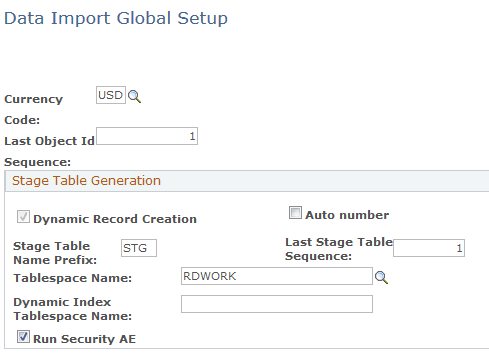Setting Up Data Import Global Settings
To set up data import global settings, use the Data Import Global Settings (RB_IMP_GLB_SETUP) component.
This topic discusses how to define data import global settings.
|
Page Name |
Definition Name |
Usage |
|---|---|---|
|
RB_IMP_GLB_PG |
Define global settings that are for the Data Import process. |
Use the Data Import Global Setup page (RB_IMP_GLB_PG) to define global settings that are for the Data Import process.
Navigation
Image: Data Import Global Setup page
This example illustrates the fields and controls on the Data Import Global Setup page. You can find definitions for the fields and controls later on this page.

|
Field or Control |
Definition |
|---|---|
| Currency Code |
Enter the default currency code, which the Data Import process uses for target tables that require a currency code. |
| Last Object Id Sequence |
Enter a starting integer. Use this field when you create object IDs that are not system-generated. The format of generated IDs is sequence number:counter. For example, if the starting sequence number is 1, and you import a file with 100 companies, the format of the generated IDs is 1:1 through 1:100. A subsequent load of 50 company objects generates IDs 2:1 through 2:50. |
Stage Table Generation
|
Field or Control |
Definition |
|---|---|
| Dynamic Record Creation |
Indicates that tables are dynamically created during the Data Import process, which executes many CREATE TABLE statements during processing. This is necessary to stage the imported data and to perform matching logic. You cannot edit this field. Note: The PeopleSoft super user ID must have Create Table privileges for the process to finish successfully. |
| Auto number |
Select to enable automatic number generation for imported data. |
| Stage Table Name Prefix |
Enter the prefix for the staging tables. The staging tables are defined as prefix_numeric value (for example, STG_215). The system assigns numeric values in sequential order. |
| Last Stage Table Sequence |
Enter a new sequence number, or leave the default, which is the last stage table sequence that the system creates. The system automatically assigns table sequences during the Data Import process. If you enter a new number, the system uses that number as its starting point in the process. |
| Tablespace Name |
Enter the tablespace name under which you want the system to create the staging tables. PeopleSoft CRM provides the predefined table space name (RDWORK). Note: When performing the Data Import process on an Oracle or DB2 platform, you must define a SQL space name. |
| Dynamic Index Tablespace Name |
Select PSINDEX for Oracle databases and PSSGIXPT for DB2. Tablespace fields are enabled for DB2 and Oracle databases only. Note: If you need to specify a different tablespace, you must manually enter it in Query Analyzer. |
| Run Security AE (Run Security Application Engine) |
Select this check box to run the security AE process against imported data. If this is not selected, imported data will not be available for applications that use application security. Note: You can run the security AE against the entire database at a later time to make this data available. |